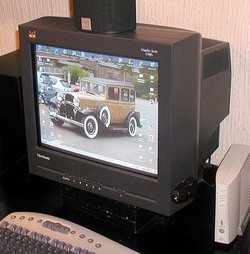Computer display
|
|
| Contents |
Technologies
As with television, several different hardware technologies exist for displaying the actual image:
- Cathode ray tube (CRT)
- Liquid crystal display (LCD). They can receive TV and computer bands (SVGA, PAL, SECAM; NTSC).
- Plasma display (rarely seen)
- Video projector
A modern CRT display has considerable flexibility: it can often handle all resolutions from 640 by 480 pixels (640״80) up to 2048 by 1536 pixels (2048ױ536) with 32-bit colour and a variety of refresh rates.
The sharpness of a display is described by its dot pitch. In general, the lower the dot pitch, (e.g. .24), the sharper the picture will be.
Early CRT-based VDUs without graphics capabilities gained the label "glass teletypes", because of the similarity to their electromechanical predecessors.
Black and white displays can only display one colour either as on or off. Monochrome displays can show only levels of a single colour. In both cases the display usually uses green, orange (amber) or gray (white).
Monitor.jpg
Colour monitors may show either digital colour (each of the red, green and blue signals may be either on or off, giving eight possible colours: black, white, red, green, blue, cyan, magenta and yellow) or analog colour (red, green and blue signals are continuously variable allowing the display of any combination). Digital monitors are sometimes known as TTL because the voltages on the red, green and blue inputs are compatible with TTL logic chips.
Most modern computer displays can show thousands or millions of different colours in the RGB colour space by combining red, green, and blue dots in varying intensities.
Some display technologies (especially LCD) have an inherent misregistration of the colour planes, that is, the centers of the red, green, and blue dots do not line up perfectly. Subpixel rendering depends on this misalignment, and was used by the Apple II in 1976 [1] (http://grc.com/ctwho.htm), and more recently by Microsoft (ClearType, 1998) and XFree86 (X Rendering Extension).
Moving texts can appear in italics, even when the display resolution is too low to show static italics: a fractional time delay causes an apparent corresponding shift of a fraction of a pixel.
Multi-head
Some users use more than one monitor. The displays can be used in multiple modes. One of the most common puts the desktop on all of the monitors, acting as one big desktop. This is called "Xinerama" in X11. A monitor may also be setup to clone another monitor. Using two monitors is often called dualhead, while three monitors are often called triplehead.
Major manufacturers
See also
- Additive color
- Gamut
- Multisync
- Display device
- Graphical output device
- Refresh rate
- Screenshot
- XFree86
- MaxiVista
- Comparison of display technology
External links
- How stuff works (http://electronics.howstuffworks.com/monitor.htm) - How Computer Monitors Work.
- LCD Monitor (http://www.lcdmonitor.org/) - Explains how LCD monitors work and compares them with CRTs

